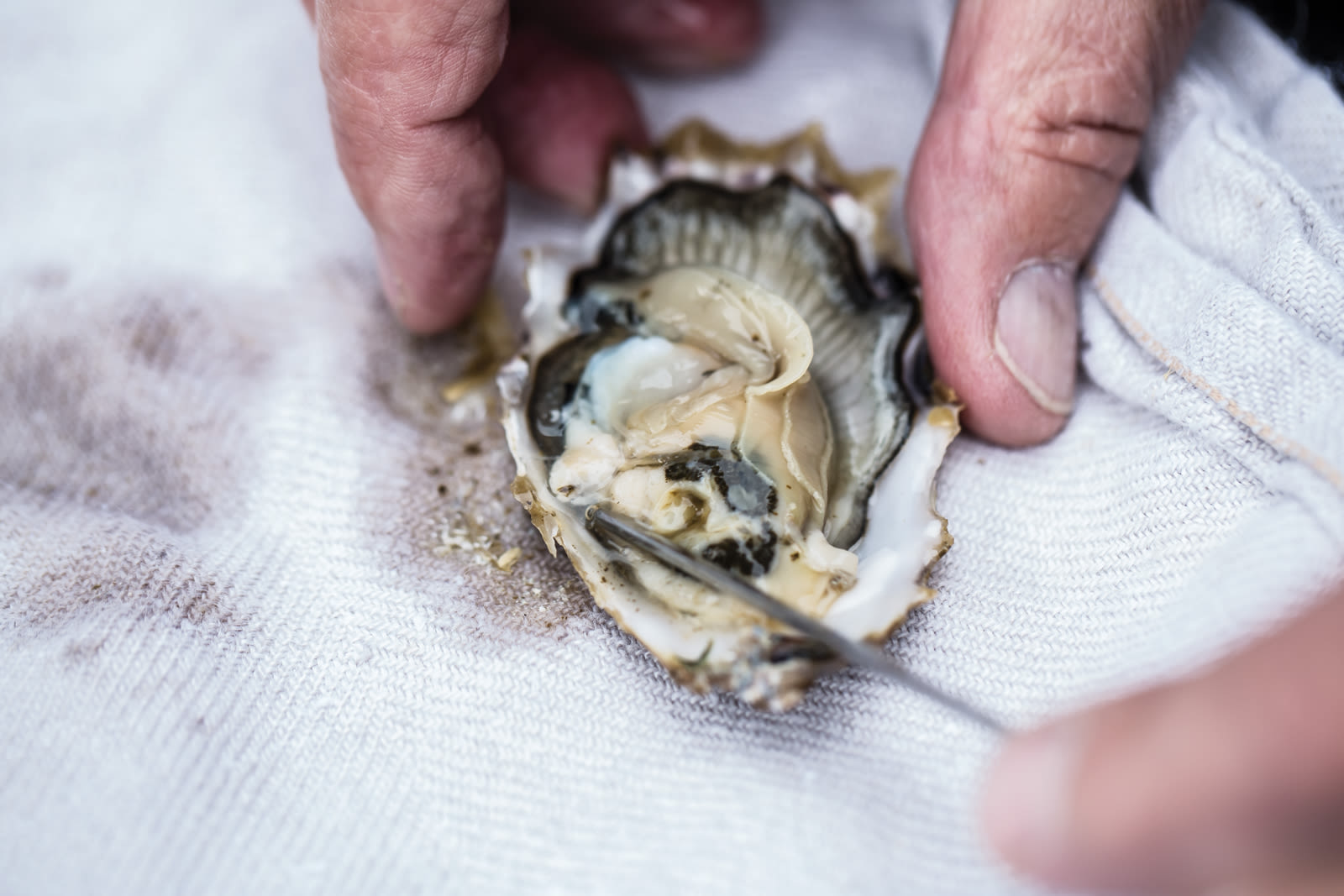
The 5 Oysters You Meet in Washington
Oyster platters are typically an exercise in comparing flavors from different bodies of water. Sometimes they’re just an exercise in eating a bunch of them, because they’re oysters and that’s reason enough. But rarely do you encounter one of these round, ice-packed metal pans whose occupants could actually be classified as four distinct types of oyster. Imagine, the smallest is petite as a bottle cap; the largest could fill your entire mouth. Each arrived on this platter through a combination of history and happenstance, obsessive farmers, good old-fashioned capitalism, and a local food culture that’s grown to like its oysters raw and straight from the shell.
They pack enough intrigue to kick off a four-star dinner, yet are so low key you can pick one up directly off the beach and eat it next to a campfire. Their breadth of shapes and flavors can obscure the fact that across the U.S., people eat just five different oyster species. Washington might be the only state whose tidal beds are home to all of them.
So, yes—there’s a fifth oyster missing from this platter. It’s here, though, growing in the state for the first time in half a decade. We’ll get to it soon enough. But when becoming acquainted with the ridiculous riches handed down to us by ecology and dedication and sheer dumb luck, it seems sensible to start with the one you’ll find all over town.
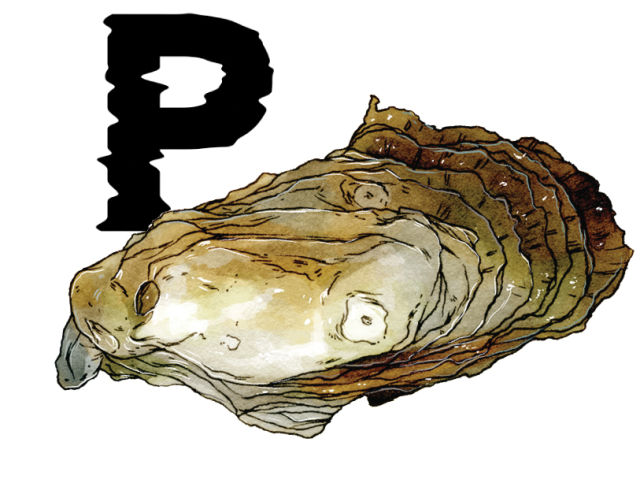
Illustrations: Michael Hoeweler
The Pacific Oyster
Crassostrea gigas
Order oysters at any restaurant with a respectable supply and an unspoken confusion hangs in the air while your server raves about the charms of a Baywater Sweet or a Hama Hama or a Treasure Cove—98 percent of the oysters grown in Washington are Pacifics. Some say the actual number is higher.
Which is not to say Pacifics are all the same; these bivalves are a briny microcosm of humankind. They can be portly or petite, sweet or harsh, depending on the circumstances that the fates—or in their case, the tides—have dealt them. Like us, oysters that eat more food are fatter; those that dwell by the sea come out saltier; the ones that survive hardship emerge with a stronger shell.
The ecological term for this is phenotypic plasticity. The marketing term for oysters adopting the characteristics of their surroundings is merroir—a portmanteau of “marine” and “terroir.” Though you’d be hard pressed to find anyone in the oyster industry use this word with a straight face.
It’s the endless nuance that makes this otherwise inert creature interesting. Also, confusing. In the same vein as choosing a bottle of wine based on the cute animal on the label, it’s easy to go to an oyster bar and simply order the most charming names—Calm Cove, Pickering Passage.
Not Jeff Daniels. Though he understands the Pacific oyster better than most, he doesn’t spend his days walking along scenic, fir-fringed tidelands. He reports for work each morning to a low-slung industrial building in SeaTac, in the shadow of a federal prison. He’s skinny and earnest and probably tired of jokes comparing him to the actor.
Since 1987, Daniels has worked for Marinelli Shellfish; now he heads the Seattle office, distributing roughly 25 oyster varieties from around the Northwest. Oyster farmers arrive twice a week to deposit the harvest collected by headlamp light during last night’s low tide. Most are ultimately destined for high-end restaurants, or the huge market in Asia.
“Pacifics all finish with that cucumber-melon flavor,” Daniels explains as he rummages through mesh sacks of oysters stacked along the walls of a giant walk-in cooler. “They all start with some degree of salt.”
With a single twist of his arrow-tipped knife, Daniels shucks a Cummings Point oyster from just north of the Hood Canal’s Hamma Hamma River delta where pure, cold mountain runoff harbors relatively little for an oyster to eat. This one lived the clarifying life of an ascetic: hardly any fat, which is to say hardly any sweetness; just a whisper of salt.
By comparison, he offers a Flapjack Point, its meat cloaked in milky white fat after months spent gorging on all the algae in the brackish salt waters of southern Puget Sound. Maybe it’s the appellation inspiring thoughts of breakfast, but this oyster suggests eating bacon by the sea: a burst of salt giving way to sweetness; a combo that lingers on the palate, thanks to all that fat.
The first Pacifics arrived in April 1919 on the deck of a steam ship bound from Yokohama, Japan, and destined for a pair of Japanese-born oyster farmers, Joe Miyagi and J. Emy Tsukimoto. The two grew up in Olympia, spending school vacations shucking or working the nearby oyster beds, where the state’s stock of native Olympia oysters were dwindling—along with the profits. An oyster from Japan, they thought, might prove a good substitute.
Dubbed the “Japanese oyster” and thrust into a completely unfamiliar ecosystem, this hardy, fast-growing specimen grew like gangbusters. But Miyagi and Tsukimoto didn’t have long to relish their success. In 1921, Washington passed the Alien Land Law, making it illegal for Japanese residents to own or even lease land. By 1930 there were enough farmers (white farmers) growing the Japanese oysters to form an industry group, one that agreed it needed a more homegrown moniker. They chose the name Pacific oyster (alternatives: Cascade, Western, and Chinook) though it eventually faded into the background as we adopted the French habit of naming oysters for the bays, coves, and inlets that shape them. These days, some farms go a step further, tumbling Pacific oysters in bags that flip with the tide—the jostling smoothens the shells and firms the meat until they can almost masquerade as a pricier Kumamoto.
As a forklift and pallet jack maneuver behind him, Daniels kicks things into serious oyster geek gear: Wolf Beach, Barron Point, and Eagle Rock oysters. Three varieties from the same farm, from three beaches close together along the Skookum and Totten Inlets. Each oyster comes from its own microecosystem, like three households on the same street. A census taker might lump them together, but anyone who’s familiar knows the freshwater-blockading eddy on Wolf Beach makes oysters more salty, and cosseted Barron Points have good salt but give way to massive sweetness.
Of course, these particulars can change week by week, as deluges of rain make water less salty or longer days bring sunlight and more algae to eat. And in summer, says Daniels, “Throw all my descriptions out the window.”
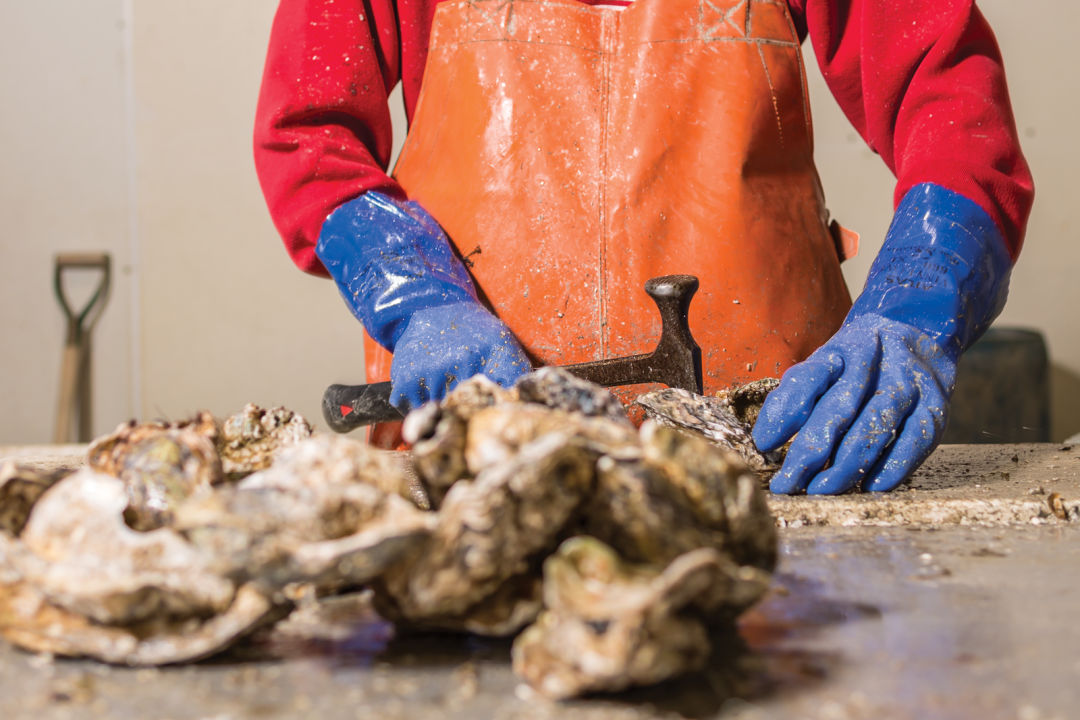
A worker at Bay Center Farms on Willapa Bay shucks oysters to be sold by the container.
Image: Cameron Karsten
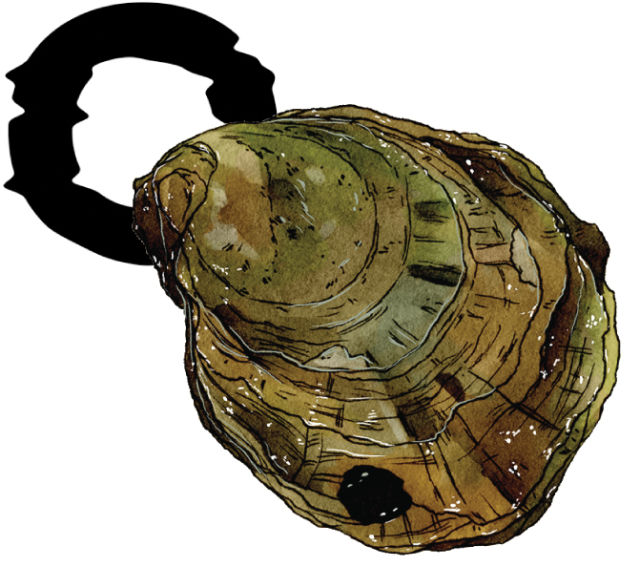
The Olympia
Ostrea lurida
In the early 1850s, the ambitious headed to California in search of gold, but the truly entrepreneurial soon sailed north, where the coppery flavor of Washington’s only native oyster proved a more likely path to riches. We weren’t even our own territory yet, but we did have bays full of tiny bivalves, and the Golden State had a swelling population of newly well-to-do gold hunters willing to pay big money to eat them.
After a diet of bread and beans and salt pork in the gold fields, successful prospectors wanted to throw around their newfound wealth. The locavore movement was a century and a half away, and any suitably celebratory foodstuff was shipped from the east—except our oysters. These bivalves are barely bigger than a postage stamp, their gently curved shells vaguely resembling the Shell gasoline logo. Each might fetch a dollar. But these oysters packed a big flavor, a clanging metallic taste like licking a spoon you found at high tide.
Jon Rowley grew up in Astoria, on the knuckle of Oregon coastline just 30 minutes down Highway 101 from where the first oyster-seeking schooners nosed into the Willapa Bay, in 1851. But even he—a man who spent his entire adult life working with seafood—knew Olympias only as shucked meats in little glass jars that showed up on the table every Thanksgiving.
These days, Rowley’s a snowy-haired guy with heavy-lidded blue eyes that gleam when he flashes his crooked smile. He always looks like he just told a mildly dirty joke. His voice is so soft you have to lean in to hear, a funny quality in a guy known for creating the cachet surrounding certain seafood, like salmon from Alaska’s Copper River.
In the early ’80s, “I started asking around, and nobody ever remembered there being any Olympias sold on half shells in the city,” Rowley recalled one day over a platter of oysters. By the 1950s, overzealous harvesting, the arrival of Pacifics, and pulp mill pollution in the south sound had stripped Washington of its very own native oyster.
He was consulting for the seafood restaurant Ray’s back then, and figured his client would be psyched to reintroduce Washington’s long-lost oyster to diners just now coming around to the idea of eating them fresh and raw and on the half shell. Rowley made queries, then headed to the southern fingertips of Puget Sound where he knocked on doors in likely places. He found four farms that had quietly kept on growing Olympias long after they disappeared from menus.
Which isn’t easy. They die off readily and, even though they’re tiny, they still take four maybe five years to grow to full size. Olympias are happiest submerged in water, a biological quirk that would, weirdly, have great implications for our state. Back in the 1800s, during the California feeding frenzy, harvesters figured out they could grow way more of them if they built dykes along beaches, keeping their coppery charges constantly protected in about six inches of water. With that simple act, oyster harvesters became oyster farmers. Next problem: Beaches were public land. Farmers had no legal means to protect their crops—save fisticuffs or running encroachers off the tide flats with a shotgun.
When Washington became a proper state in 1889, our newly minted legislature set about legalizing private ownership of tidelands. This is wonky, but important: Nowhere else in the country can anyone privately own tidelands. Other states hold them in trust.
A century later, Olympias have been restored, at least modestly, to menus and their original, natural beds. You could argue that ownership was why Rowley’s newfound oyster acquaintances still cared enough to quietly preserve them, even though the big money was in those fast-growing Pacifics. The taste of an Olympia may never be a crowd-pleaser, but today we experience its coppery twang by the grace of farmers who view their tidal beds as a source of revenue, yes, but also identity.
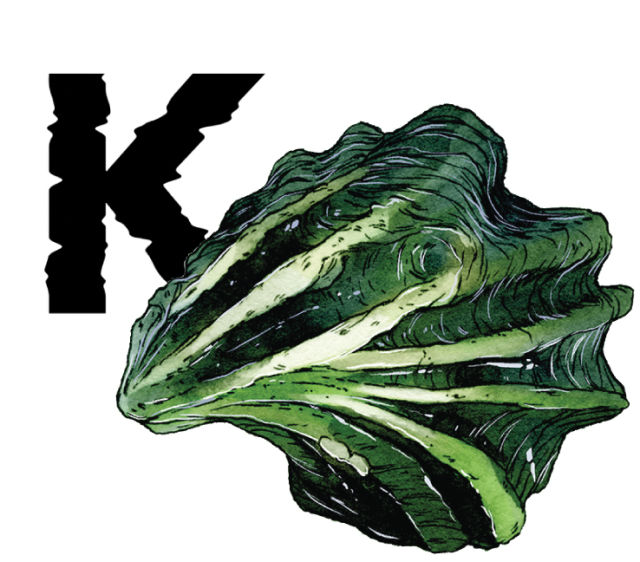
The Kumamoto
Crassostrea sikamea
In a 1976 restaurant review in The Seattle Times, writer Alf Collins chronicled his experience at a waterfront fish house in Tacoma. What this joint passed off as oysters on the half shell earned a gleeful evisceration: “We got bottled oysters plopped down on shells. There were two or perhaps three pasty little cadavers heaped in some of the shells,” he wrote. “They had been cleansed of any hint of their juices before being served.”
These were dark days for oysters.
But a resurgence was brewing, particularly for the Kumamoto. This elegant little mollusk came into its own when people started viewing oysters as a gourmet experience rather than a commodity food summoned from the pantry as needed for soups, stews, or an appointment with some reusable shells that would later get run through the dishwasher.
As long as humanity has known about oysters, people have been eating them raw and straight from the shell. But most of Washington’s oyster-harvesting history involved waterside shucking houses where workers use small hammers to bash apart bananalike clusters of oysters. Meat was then pried from the busted-up shells and packed in a jar or tin.
Kumamotos arrived here in 1947, when Washington’s oyster farmers were scrambling to reestablish Japanese sources for oyster seed after World War II. But while Pacifics procreated with relative abandon, our waters were too cold to get Kumamotos in the mood to reproduce naturally. The oyster’s name was a hard sell to a generation that had just fought a war with Japan. They also took an infernally long time to grow.
Brady Blake, a shellfish biologist for the Washington Department of Fish and Wildlife, first remembers the Kumamoto resurfacing as a sort of novelty item at conferences in the late 1980s. “Lots of people were interested in it,” he recalls. Which makes sense: Our fascination with destination restaurants and local ingredients was taking hold. Sushi made raw fish cool.
If you’re iffy on the idea of eating a raw oyster, there’s no better one to learn on than the Kumamoto, conversationally shortened to Kumo. It’s relatively small and manageable in the mouth. The bottom shell is deep and furrowed; it looks a bit like a cat’s paw. That deep cup is almost like training wheels for the act of tipping its contents onto your tongue—its liquor is less likely to dribble inelegantly down your chin. But mostly it’s the flavor, that subtlest of brine upstaged by creamy sweetness.
Most Washington Kumos come from Taylor Shellfish via its own hatchery. While the company once sold 85 percent of its oysters already shucked, today 85 percent of its business is live oysters destined for half shell service, maybe 10 percent of them Kumamotos; they also come in cardboard presentation boxes, like fine cigars or jewelry.
It’s still difficult for smaller local farmers to get their hands on Kumamoto seed, but Jeff Daniels of Marinelli Shellfish, the man so attuned to the nuances of Pacific oysters, thinks a completely different culinary landscape isn’t far in the future. After ocean acidification strafed the region’s oyster seed supplies five years ago, the state encouraged farmers to start their own small hatcheries. “Someday when lots of people are growing Kumamotos,” Daniels predicts, “maybe we’ll see Kumo menus like we do Pacifics. There could be Lopez Island Kumos…Puget Sound Kumos.” Most importantly, there could just be more of them.
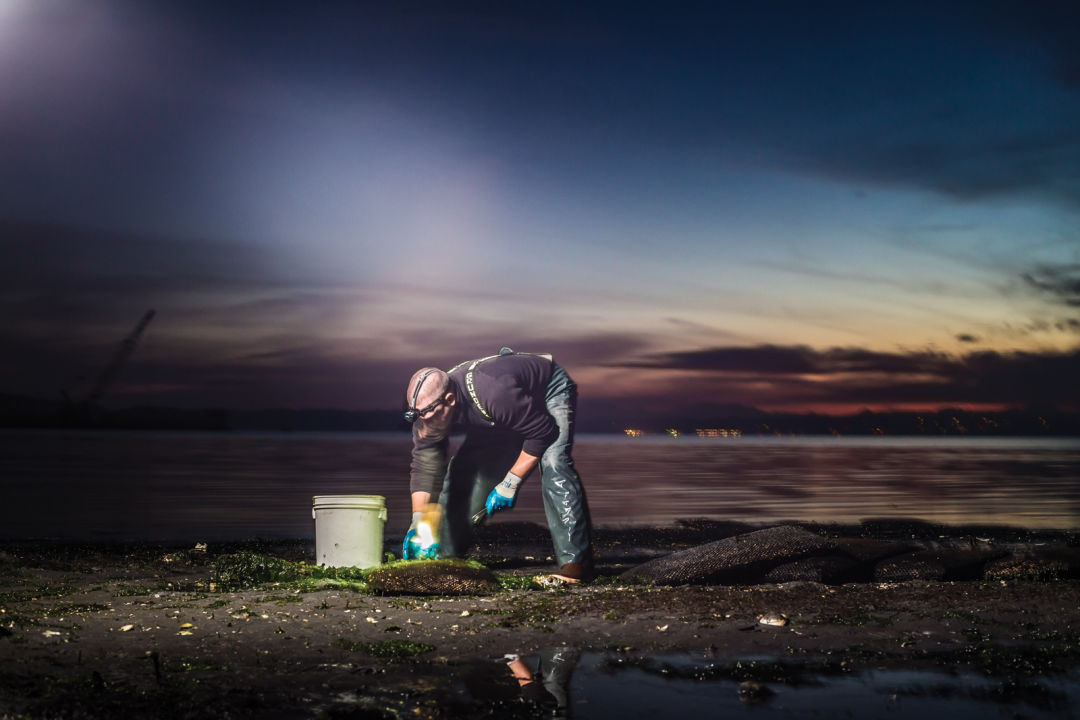
Volunteers with the Puget Sound Restoration Fund harvest Olympia oysters grown from seed in Port Madison.
Image: Cameron Karsten
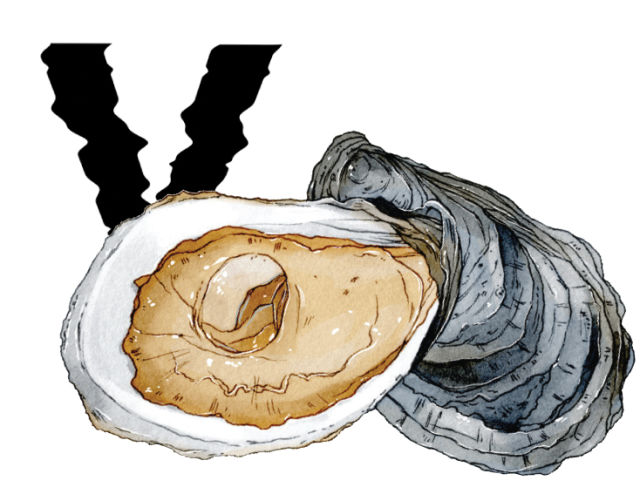
The Virginica
Crassostrea virginica
The rivalry between East Coast and West Coast oyster lovers will likely never reach the braggadocio heights of the feud between East and West Coast hip-hop. But a defining moment happened in 2008, in the world’s most nondescript beige banquet room at the Westin in Providence, Rhode Island.
Here, 19 oyster farmers from 11 states along the Eastern seaboard, Louisiana to Maine, toted wheeled coolers of oysters. They came for the first-ever oyster tasting invitational, put on by the industry to celebrate the glories of its native eastern oyster, also known as the Virginica. Some of the noblest American oysters—Wellfleets, Blue Points, Moonstones—are Virginicas. They dwarf a typical West Coast oyster, with big salt and that slight but telltale crunch when you bite into the meat.
There was an outlier in the group. Brothers Bill and Paul Taylor had flown in from Washington state with a cooler full of their Virginicas, grown along the thickly pined shores of the Totten Inlet, in the southern reaches of Puget Sound.
They were invited, Paul Taylor recalls, “just to add some mystique to the competition.” And because Taylor was one of the most recognized names in oysters, even on the opposite coast.
The Taylor family’s oystering roots stretch back to one of the state’s earliest farmers, J. Y. Waldrip, who as legend has it took a short oyster hiatus to ranch with Wyatt Earp in Arizona. It was about that time, in the 1890s, that batches of Virginicas first arrived here by train, when farmers were still casting about for a replacement for overharvested Olympias. A few decades later, Paul and Bill’s father Justin, a taciturn navy veteran with a high school education and an endlessly curious mind, revived the business. He also spent a lifetime advocating for cleaner waters in Puget Sound. Paul and Bill, now 58 and 59, joined their dad straight out of college. Along with their brother-in-law, the Taylors now run the largest oystering company in North America, owning or leasing 10,000 acres of tideland in Washington and British Columbia, and running hatcheries and nurseries in Hawaii and California and locally on Dabob Bay, in Quilcene.
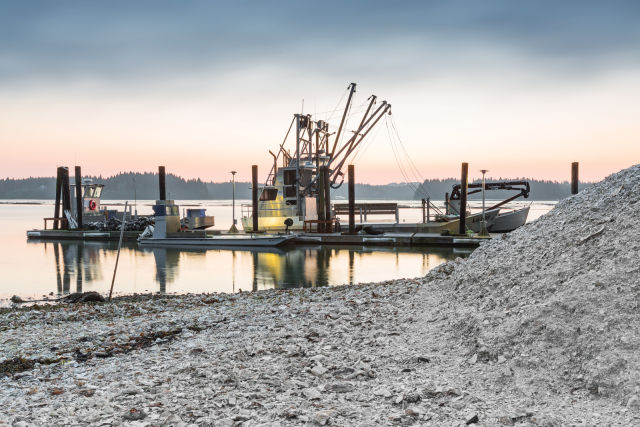
Sunrise over the Willapa Bay, where mounts of oyster shells become beds for small seedlings.
Its size means Taylor Shellfish exerts all manner of influence over Washington’s oyster industry. The family sells oyster seed, Pacific mostly, to smaller farms, and invests a lot of resources into figuring out how to best cope with the ocean’s rising acid levels. The company also grows the only Virginicas available in Washington state.
Those Virginicas, tasted by a 10-judge panel at that Rhode Island invitational with the aid of lemon wedges and hot sauce and certainly bottles of beer, earned the prize for best flavor and placed second overall. It wasn’t exactly surprising. They’re sort of an oyster everyman—large, but not too big. Briny, but not like you just wiped out on a surfboard. You’ll seldom see these Totten Inlet Virginicas outside Taylor’s own oyster bars, especially now that there are three of them—and a fourth on the way in Bellevue.
Problem is, they’re really tough to grow here, says Paul Taylor. The family has grown Virginicas from Willapa Bay to the south sound, but they only seem to like the Totten Inlet.
“I don’t know why,” Paul admits. “I really don’t. The other areas have a high mortality rate; they just wouldn’t get large enough to sell.” The oysterman has a few guesses—namely that Virginicas are particularly adept at gobbling Totten’s plentiful algae. But the inexplicable is a given in oyster farming.
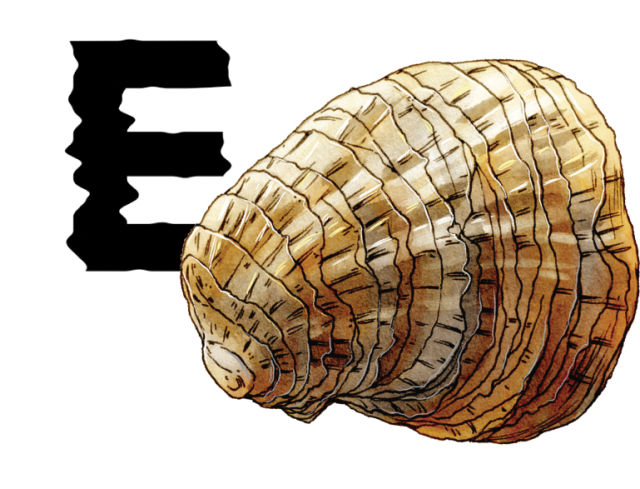
The European Flat (Belon)
Ostrea edulis
Nick Jones farms oysters on Lopez Island and shares an email address with his wife, Sara, whom he refers to fondly as “mother.” So one could be forgiven for stepping off the ferry at the island’s tiny station and foolishly assuming there would be a sage, weather-beaten sort waiting there, maybe bearded…probably in his 60s. Instead it’s a tall 38-year-old rolling up in his black pickup, tan with both a light dusting of freckles and wire-rimmed spectacles perched on a rather delicate nose. Swap out his beat-up red buffalo check shirt and wading boots for a cape and he could be a willowy Hogwarts extra in a Harry Potter film.
Nick Jones may not be sage or weather beaten on the outside, but he packs as much knowledge of his trade as a guy who’s been doing it decades longer. He can quote Jack London and state shellfish testing regulations with equal ease and is prone to spouting bits of off-the-cuff wisdom like “Oysters are like children; you put them side by side and their performance will be wildly variable.” His Jones Family Farms raises cattle and produce and harvests shellfish on the island. Here Jones is also raising the fifth species of edible oyster, one that’s been absent from our waterways, by his estimate, for five years.
As the name implies, European Flat oysters are native to countries like England and France, where they’re also called Belons. These oysters once grew thick in the Thames and defined Parisian oyster bar culture. They came to the U.S. in the 1950s, and while you might find a few pockets in Maine, today you’re about as likely to find one in Washington as you are a locally grown coconut. They’ve been farmed here sporadically, but some feared the oysters were too prone to disease. Jones himself grew Flats, but had to give up when he was no longer able to get seed.
But he missed the oysters. So much so that he decided to start a hatchery so he could perpetuate his own European Flat seed. More accurately, he and his wife bought one of the state’s early oyster hatcheries and hauled it here piece by piece from Westscott Bay. It sits now at the edge of a little lagoon, a shantytown Nick Jones fondly refers to as “our lowbrow fertility clinic.”
There’s a structure resembling a wooden outhouse growing five types of algae (hey, oysters need balanced diets just like people). An old shipping container full of grow lights, also for the algae. A greenhouse of sorts where larvae grow in fiberglass tanks the size of bathtubs. The reproduction itself is a prosaic matter of buckets and hoses.
The hatchery also produces Olympias and Kumamotos, plus clam and geoduck seed that are handy for cash flow. But this entire adventure was undertaken for the sake of the Flats.
And not without a learning curve. Until they’re about three millimeters big, says Jones, “larvae are looking for reasons to die.” Each crop has its own ideal set of water conditions, ones Jones must figure out through trial and error. “It’s biological roulette,” he says. “You’re stacking variable on top of variable on top of variable. If we get it right 10 percent of the time, we’re geniuses; 2 or 3 percent and we’ll survive.”
Since the hatchery opened four years ago, Jones has sent the occasional batch of Flats to local restaurants. There was one rough year he didn’t have any.
Finally, the learning curve is bending slightly. Last year’s crop, piles of flat little moons, are submerged in the man-made lagoon just outside the hatchery in rows of brown plastic trays. Millions more seedlings are growing, preparing to be transferred into the water. By next year, says Jones, his Flats could be a fixture on seafood menus.
The oysters may be notoriously fussy, but at least in this water, says Jones, they grow fast and the quality is high. “They like a murky backwater with a good exchange,” he explains, boots crunching across the lagoon bottom strewn with pebbles and bits of oyster shell. It’s hardly more than a dimple in the ground at low tide, but rich in plankton blooms, even in winter.
Later he’ll sit in the sunshine watching the sailboats on Shoal Bay and hand over a European Flat. The minerality scrapes the tongue, and the taste is almost metallic until softened with a sort of buttery roundness.
More familiar oysters, the kinds with ruffles and deep cups, can be ushered down the throat casually; this oyster is a delicate saucer, its shape an indication, a demand really, that you go slowly and remember every single moment.




